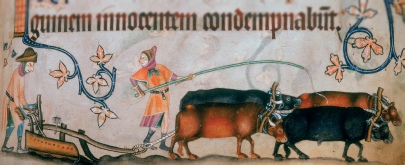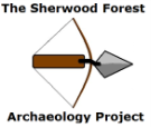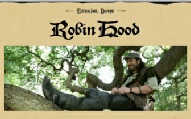Medieval society and the medieval landscape were for the common person predominantly rural and agricultural in nature.
Very little of the landscape was not utilised, and in some areas such as the ‘Champion’ (from the French champ-
In Sherwood Forest it was similar, in that almost every resource was used.

Every village had its great open fields, where crops were rotated through the season, and the people farmed strips of land spread throughout them. Each year one field stood fallow to recover for the following years crops.
This fallow field was fertilized by the animals of the village. Pigs and sheep would be concentrated at night into temporary pens to ‘focus’ their fertilization efforts.
Between these times it was necessary to graze animals away from the open fields.
No matter how much an animal fertilises a field it will always take more nutrients than it returns, if it grazes exclusively from the same field that it fertilises, as it requires nutrients to grow.
An external source of nutrients and energy was therefore required, and in Sherwood Forest this came from the great areas of open wood-
Shepherds and swineherds would tend their flocks and herds on these vast swathes of lowland heath and tree-
Each parish also had their own areas of woodland, usually at their edges. Some of these were more typical enclosed woods with lots of trees and a closed canopy environment.
Others were open to grazing and probably had less dense tree coverage with areas of more open heather and gorse and grass within them (wood-
In the more populated southern ‘Thorneywood’ area these woods occupied the high ground between villages. Good examples were those on the ridges between the villages of Lambley, Woodborough and Calverton.
These woods often joined together to form giant areas of woodland which collectively covered miles. However, they each had names reflecting to whom they belonged, and would have been individually managed, through coppicing, to provide wood for the villagers.
Coppicing is where trees are cut down at the base of the trunk. The subsequent re-
Carleton Wode, Gedling Wode, Basforde Wode (named after villages) Kettulbarne Haw, Fox Swaht, Prior Stobyn, Samson Wode (after landscape features or owners past and present) were all examples of such coppiced woodland in this southern part of the Forest.
Often in such woods in among the coppiced trees certain trees were allowed to grow naturally to provide larger timber trees. These were known as ‘Standard trees’ and the resulting woods were known as ‘Coppice and Standard’ woods.
In the ‘High Forest’, (the northern part of Sherwood Forest) woodlands were sometimes vast such as the great Maunsfelde (Mansfield) Wode, Sutton Wode, Blidworth Wood and Hay Wode, as well as the great crown woods of Lyndhurst, and Hays of Birklands and Bilhaugh.
Many of these woods were open to grazing and were therefore often wood-
In this environment old veteran trees dominated as grazing livestock (and deer) keep new trees from developing in large numbers.
New trees do gradually emerge, often having survived and grown to a large enough size within clumps of protective gorse.
It is worth remembering that nobody could cut down the large trees in any of these woods without express permission from the King because it was forbidden by Forest Law. Even by the great landowners unless they had a prior arrangement.
However common people could gather wood for house building, domestic fires, hedge making, fencing and other uses.
They could also take turves from the heather lands for burning, and ferns for fertilising (see below), as well as gorse for animal fodder.
Of course also collecting nuts, berries and all the fruits that the forest provided was not forbidden under Forest Law.
These rights were heavily guarded by the people.
As well as the rights to pasture in the open wood-
One such time was the ‘Pannage’ season (just after the acorns fell) when peasant could graze their pigs on acorns in the woods of the forest.

Picture: A peasant beating acorns from the tree for his pigs
These rights to access woods were strictly controlled under Forest Law with ‘Agisters’ acting as tax collectors to control quotas and extract fines.
An Inquisition Post Mortem into the rights of the people of Clipstone Manor, dated 20th April 1327 early in the reign of Edward III shows some of the rights of the peasant to the resources of their land.
The Inquisition was presented in front of John De Crombwell Keeper of the Kings Forest beyond Trent, by the oath of John de Annesley; Philip de Caltoft, knight; Thomas Whaton; Richard Russell; Richard Ingam; John de Holm; Richard de Bestewod (Bestwood); Thomas de Lyndeby; Simon de Lameley; John le Warde of Crathethopre; William Basage; and john Moigne of Carleton…
‘The King’s tenants of his manor of Clypston in Shirwod (Sherwood), which is of ancient demesne of the crown of England, and their ancestors, tenants of the same manor, from time immemorial have been accustomed to have all ferns growing in a place which is now called the park of Clypston, for thirteen shillings and six pence, to be rendered yearly to the King’s ancestors by the hands of the justice of the Forest; and to collect the leaves fallen from the trees in the same place for manuring their lands, without rendering anything therefor; and to have pasture for all kinds of beasts in the same, doing in return the custody of the vert and venison in the same place by two of the tenants’.
This shows how the peasants had customary rights to access the ‘park’ for livestock grazing, and to gather ferns and leaves for fertilizer, (in exchange for looking after the deer and timber for the King)
It also shows that they were empowered enough to appeal through the court system to protect those rights.
The reason for the inquest is that Edward II had closed off access to the park, preventing them from their customary rights. The newly crowned Edward III was being petitioned by the men of Clipstone to have their rights returned. They also informed the King that he was losing the money they would normally pay for their rights!!!
Presumably he would be more likely to listen if his wallet was affected.
The men also pointed out that they could not get sufficient pasture outside of the park for their needs-
So as can be seen the landscape of Sherwood Forest provided opportunities for people to make their living from agriculture and from accessing the resources that the Forest provided around them. It was also the case that people would guard these rights vigorously, petitioning through the courts and to the legal system.
The laws of the land prevented many people from having many things, but they also enshrined rights over generations and the law could be called upon to protect those rights if they were threatened.
(Andy Gaunt, First published 01/12/2012, updated 23/04/2020)
Click here for more ‘Stories from the Forest’…



Community Archaeology Nottinghamshire, Community Archaeology Derbyshire, Community Archaeology Leicestershire, Community Archaeology East Midlands, Mercian Archaeological Services Community Archaeology for Nottinghamshire, Derbyshire, Sherwood Forest, Leicestershire and the East Midlands. Community Archaeology Nottinghamshire, Community Archaeology East Midlands, Community Archaeology Leicestershire. Archaeological

Daily life in Medieval Sherwood Forest
Award Winners 2016
for "Engaging people in the heritage, history & archaeology of Sherwood Forest".





Some funders and partners:
World-











The Future of Sherwood’s Past
Project page links:
-
-
-
-
-
-
-
-
The Sherwood Forest
National Nature Reserve Archaeology Survey
-
Long term Research at
King John’s Palace:
Ancient Royal Heart of Sherwood Forest
-
The Sherwood Forest Archaeology Training Fieldschool
-
“Scirwuda-
Ghost and Shadow woods of Sherwood Forest Project
-
Investigating Thynghowe Viking
Meeting Site
-
Searching for the
The Battle of Hatfield
-
-
Fieldswork at St Edwin’s Chapel
-
St Mary’s Norton-
-
Mapping Medieval Sherwood Forest
-
The Sherwood Forest LiDAR
Project
-
Warsop Old Hall
Archaeological Project
-
The Sherwood Villages Project:
Settlement Development in the Forest
-
-
-
Researching Edward IIs fortification at Clipstone Peel
-
-
-
-
The Cistercians of Rufford Project:
Settlement Development, Dynamics and Desertion.
-
Sherwood Forest Environmental Survey
-
World War II in Sherwood Forest -
-
World War I in Sherwood Forest -
-
About Medieval Sherwood Forest
-
Robin Hood and Sherwood Forest
-
-
-
-
-
-
-
-
-
-
-
-
Mercian Archaeological Services CIC (Community Interest Company)
An Independent Research Company, specialising in Training, Community Archaeology & Public Involvement.
Community Archaeology Nottinghamshire, Excavation, Research, Volunteering, Community Archaeology Derbyshire, Training, Social, Learning, Community Archaeology Leicestershire, Heritage, Involvement, Belonging, Knowledge sharing, Community Archaeology Lincolnshire, Topographic Survey, Talks and Presentations, Outreach, Archaeology Projects , Open Days, Schools, Finds Processing, Day Schools, Field Schools, Young People, Archaeology and History of Sherwood Forest, Pottery Research, Medieval, Roman, Prehistoric, Community Interest Company, Community Archaeology Nottinghamshire.
Community Archaeology in Nottinghamshire
Community Archaeology in Derbyshire
Community Archaeology in Leicestershire
Community Archaeology East Midlands
Community Archaeology in Lincolnshire
© Mercian Archaeological Services CIC 2019. Registered Business No. 08347842. All Rights Reserved.
Community Archaeology in Yorkshire
Project page links:
-
-
-
-
-
-
-
-
The Sherwood Forest
National Nature Reserve Archaeology Survey
-
Long term Research at
King John’s Palace:
Ancient Royal Heart of Sherwood Forest
-
The Sherwood Forest Archaeology Training Fieldschool
-
“Scirwuda-
Ghost and Shadow woods of Sherwood Forest Project
-
Investigating Thynghowe Viking
Meeting Site
-
Searching for the
The Battle of Hatfield
-
-
Fieldswork at St Edwin’s Chapel
-
St Mary’s Norton-
-
Mapping Medieval Sherwood Forest
-
The Sherwood Forest LiDAR
Project
-
Warsop Old Hall
Archaeological Project
-
The Sherwood Villages Project:
Settlement Development in the Forest
-
-
-
Researching Edward IIs fortification at Clipstone Peel
-
-
-
-
The Cistercians of Rufford Project:
Settlement Development, Dynamics and Desertion.
-
Sherwood Forest Environmental Survey
-
World War II in Sherwood Forest -
-
World War I in Sherwood Forest -
-
About Medieval Sherwood Forest
-
Robin Hood and Sherwood Forest
-
-
-
-
-
-
-
-
-
-
-
-